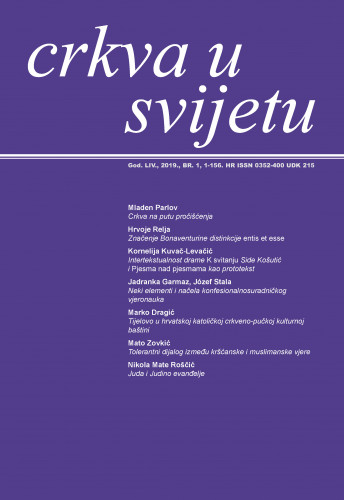U radu se pokazuje kako je sveti Bonaventura, kao uostalom i svi kršćanski filozofi, adoptirao pojam bitka kako bi na ontološkoj razini objasnio stvorenost stvorenja jer se metafizički uviđa da svako stvoreno biće, ukoliko je stvoreno, nužno prima svoj bitak od Stvoritelja. To posljedično zahtjeva da na osnovnoj ontološkoj razini stvoreno biće bude metafizički sastavljeno od bitka i njemu komplementarnog počela, a što Serafski naučitelj formulira kao sastavljenost od entis et esse. Iako sâm Bonaventura ne daje pobliže tumačenje naravi te navedene sastavljenosti od entis et esse ipak se ona dade, kako je u članku pokazano, deducirati iz njegovih osnovnih filozofskih i teoloških teza, koje pretpostavljaju prethodno pojmljenu osnovnu ontološku strukturu bića. Slijedom te dedukcije može se zaključiti da se Bonaventurina sastavljenost od entis et esse ne može interpretirati na način tomističke metafizike bitka, već da ju je plauzibilno shvatiti u svjetlu esencijalističke metafizike, i to kao sastavljenost na transcendentalnoj razini od dvaju realno različitih počela: od bîti, tj. potpuno definiranog/određenog/individualnog mogućeg bića, te od bitka, čina postojanja realnog konkretnog bića.; This paper shows how St. Bonaventure, as all other Christian hilosophers, adopted the notion of existence in order to explain, on the ontological level, the property of being created that belongs to all creatures, since it is metaphysically realized that every creature, in so far as created, necessarily acquires its existence from the Creator. Consequently, that fact requires that, on the basic ontological level, the creature is metaphysically composed out of existence and a principle complementary to it, which is what the Seraphic Doctor formulates as the composition out of entis et esse. Although Bonaventure himself does not give a precise interpretation of the nature of the aforementioned composition out of entis et esse, it can be, as it is shown in the paper, deduced from his fundamental philosophical and theological theses, which presuppose a previously delineated basic ontological structure of being. Following that deduction, one can infer that Bonaventure's composition out of entis et esse cannot be interpreted in the perspective of the Thomistic metaphysics of existence, but that it should be understood in the light of an essentialist metaphysics, more precisely as the composition on the transcendental level out of two distinct principles: essence, that is, a fully defined/determined/individual possible being, and existence, concrete being's act of existing.
Sažetak

 Crkva u svijetu : 54,1(2019) / glavni i odgovorni urednik, editor-in-chief Mladen Parlov.
Crkva u svijetu : 54,1(2019) / glavni i odgovorni urednik, editor-in-chief Mladen Parlov.